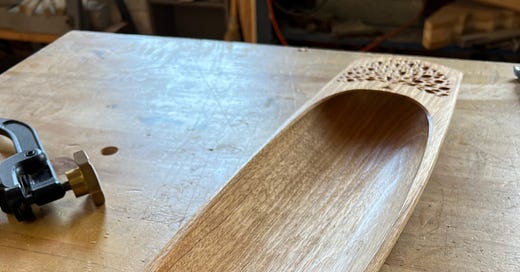I can’t tell you how many lessons I learned from Dave Fisher this week. Among other things, I was very curious about his technique for gouge sharpening. I felt vindicated by his grinding method. He grinds freehands with the gouge perpendicular to the wheel like I do. He also lays the angle much further back than it arrives from the factory and toughens it up by honing a slight curve on the interior of the bevel. But that was just the beginning of the lesson.
I’ve always wondered how Dave gets the gouge marks in his bowls to be so clean and even. Yes, years of practice have something to do with it, but so does the shape of the gouge. A sharp edge is only useful if the geometry of the edge is correct. Tools for carving require a slight curvature, or “dubbing” to perform. Without the dubbing, the tool will just dig into the surface and be nearly impossible to control. This curve is subtle. If it gets too extreme, the angle of the tool in use becomes higher and getting smooth, long, consistent cuts can be difficult. I’ve always focused my attention, and dubbing, close to the cutting edge, where the strop has the most impact. But Dave does it differently, and it makes perfect sense when you see how he uses the tool, and his results. Dave works to keep the bevel perfectly flat throughout the grinding and honing process, allowing just a slight curve to come in during the honing. Most importantly, this curve happens over the entire length of the bevel.
Keep reading with a 7-day free trial
Subscribe to Peter Galbert's Chair Notes to keep reading this post and get 7 days of free access to the full post archives.



